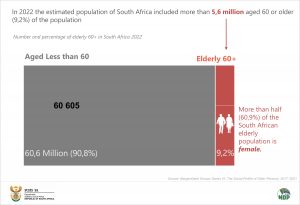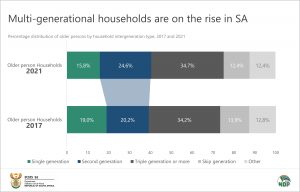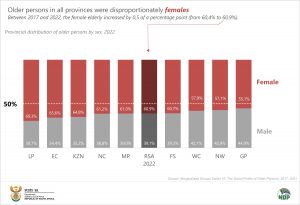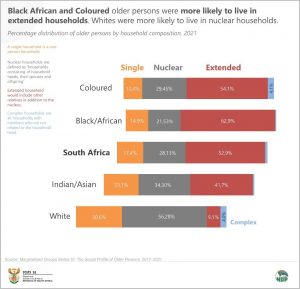SA’S elderly population increasing steadily.
In 2022 the estimated population of South Africa included more than five million people aged 60 or older. This represents a 9,2 percent share of the overall South African population.

According to a report by Statistics South Africa titled Marginalised Groups Series VI: The Social Profile of Older Persons, 2017–2021, more than half (60,9%) of South Africa’s elderly population is female.
The increase in the proportion of older persons in the population, known as population ageing, is one of the most significant social changes of the twenty-first century and is experienced by almost every country in the world. The increase in the ageing index confirms that SA’S elderly population has been increasing over time. The Ageing Index refers to the number of elderly population (aged 60 years and over) per 100 individuals younger than 15 years old in a specific population. Thus, the higher the index, the older the population. The ageing index in SA increased from 30 in 2017 to 33 in 2022.
The number of older persons increased across all provinces, with Gauteng (1,4 million) and KwaZulu-Natal (940 thousand) having the highest elderly population in 2022. However, the analysis of these numbers over time showed that Eastern Cape consistently surpassed the share of older persons in other provinces. The rise in the number of elderly persons has implications for planning and policy formulation, especially regarding the social safety nets that need to be provided for them.
As the population landscape changes, there are certainly new implications for social and environmental planning. Given that people in South Africa have emanated from diverse backgrounds and have many different characteristics, planners need to ask what kinds of housing and services older people would need? Where should housing for the elderly be located? What impact will an increasing number of older persons have on the economy, the health and transportation system?
It is therefore important for planners to understand how the ageing population in SA is evolving so that they can make informed interventions towards development and policy decisions. Increased longevity and improved health in older persons may represent significant achievements for any country. However, these trends also present significant challenges. An ageing population can impact economic growth, retirement, and patterns of work. It can affect the ability of governments and communities to provide adequate resources for older adults and includes the risk of dealing with age-related chronic diseases and disability.
Access to health care is a particular concern for all citizens of the country. However, as we age, we become prone to age-related illnesses. The three health conditions most common among older persons were high blood pressure, diabetes, and asthma. In 2017 and 2021, high blood pressure and asthma were more common among males than females, whilst diabetes was more common among females in 2021.
Inequalities in access to medical aid, whether by sex or population group, exist among older and all persons in SA. Less than a quarter (23,8% in 2017 and 23,3% in 2021) of the older persons in South Africa were members of medical aid schemes or private health insurance. Medical aid coverage was the highest for older white persons (75,7%) and lowest for black Africans (5,4%). In eight out of the nine provinces, most older persons made use of public clinics for their healthcare needs. Western Cape was the only province where older persons were more likely to utilise private hospitals/clinics/doctors than any other type of health care facility for both years.
In South Africa, approximately half of older persons live in households without any employed household members and are more likely to be found in non-metro than metro areas for both years of reporting (55,3% in 2017 and 57,3% in 2021). The largest share of households with no employed members living with an older person was recorded in Eastern Cape, Limpopo and Free State respectively. For these households, social grants, which include old-age pensions, play an important role in sustaining the families. Social grants are one of government’s interventions to combat poverty. In SA, 73,0% of the older persons are beneficiaries of an old age grant. Households headed by older persons from metros areas relied more on social grants than those in non-metro areas.
About 53% of older persons still live in extended households, where they are likely to receive some psycho-social and economic support. Households headed by older persons are more likely to live with their grandchildren as the skip-generation1 households still account for at
least 12,4% of all households in 2021.

Extended households were more prevalent (above 50%) amongst older persons than they were for all other South African households. Triple or more generation households were more common amongst the black African and coloured population groups as compared to other population groups.
Over two-fifths of black African (45,1%) and over one-third of coloured (38,8%) older persons lived in triple or more generation households in 2021. A higher percentage of older persons amongst black Africans (16,9%) were living in skip-generation households compared to other population groups. This may indicate that a larger percentage of older persons in the black African population were caregivers for their grandchildren compared to other population groups.
Analysing and tracking the changing patterns of disability and mortality for older persons helps in facilitating better policies and programmes towards reducing the dependency rates of older persons in our society.
For more information, download the full report here.
1Skip- generation families are families in which grandparents raise children and parents are absent from the household.



